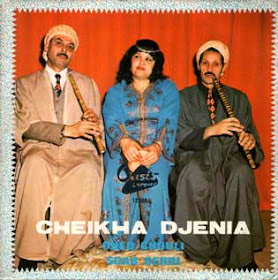Lately I've been checking out vintage recordings of songs by cheikhas, the female singers of rai who preceded the chabas, and notice something interesting -- that the practice of decorating the chaba cassettes in this manner was probably simply a continuation of the way in which 45" cheikha record jackets were decorated. Check these out, for instance. (I can't source all of these, some are from Youtube videos, and some from this great website, Mes 45 Tours, and some from Toukadime's instagram site. Check both out for more fabulous record jackets.)
What is interesting here is that whereas the chabas were doing numbers of a decidedly "modern" character (with Western instruments and all), the recordings of the cheikhas are all backed by simply gasba (reed flute) and guellal (hand-held frame drum) and are much more "folkloric." (The cheikhas however were entirely the product of "modern" processes, in particular, the dispossession of the Algerian peasantry, and the subjects of their songs equally "modern": love, the problems of marginal women, drinking, migration, etc. In any case, the apparent discrepancy between the covers of these 45's and the "sound" of the music is quite remarkable. (And hopefully someone who reads this will have something more to say on the subject.)
Cheikha Yamina el-Abbasia (the Abbasia refers to Sidi-Bel-Abbès). I don't have even any rudimentary information about her.
Cheikha Habiba Labassia
was a star of the sixties. I'm fairly certain this is not a photo of
her. It shows that not all jackets depicted Europeans, but this gallery
demonstrates that it was pretty routine.
Another Cheikha Habiba Labassia (Abbassia) cover.
And one more. Super song.
Cheikha
Habiba Saghira ("Little" Habiba, in reference to the "big" or original
Habiba, Habiba Labassia), who was a star of the seventies and eighties.
Another cover that does not feature a European, but it is a young and
glamorous girl who is no doubt not the cheikha.)
Another Habiba Saghira. This is a great song, "Yasker ou Yebki," (He drinks and cries)
Cheikha Zallamite (or, Zalamite), from Saïda. I can't find this song, but check out this.
Cheikha
Djenia (1954-2004) was born in Marhoum, a village close to Saïda, and
her career lasted from 1970 until her death. Read more about her here. Here's one of her "folkloric" recordings.
And with Djenia we actually have a recording with a picture of the star in question. And as you can see from this video her performing live, you'll note that she eventually went electric.
Chaba Zoulikha. This is interesting because (1) it's possibly a photo of Zoulikha herself and (2) Zoulikha (1957-94) was not a rai chaba, but a Berber singer of chaoui music from the Aurès in Eastern Algeria. Check out the video of her live performance of the song "Soba Rach Rach" (in Berber song, not Arabic). I don't know why she is advertised here as though she was a rai singer, as she is almost always referred to as simply Zoulikha.
And of course the most famous of the cheikhas, Cheikha Remitti (more commonly spelled Rimitti). A great recording from the sixties.
And another one from Remitti. Great song.
And this is a photo of Rimitti that probably dates from before she became famous in the world music scene, in the late eighties.













No comments:
Post a Comment